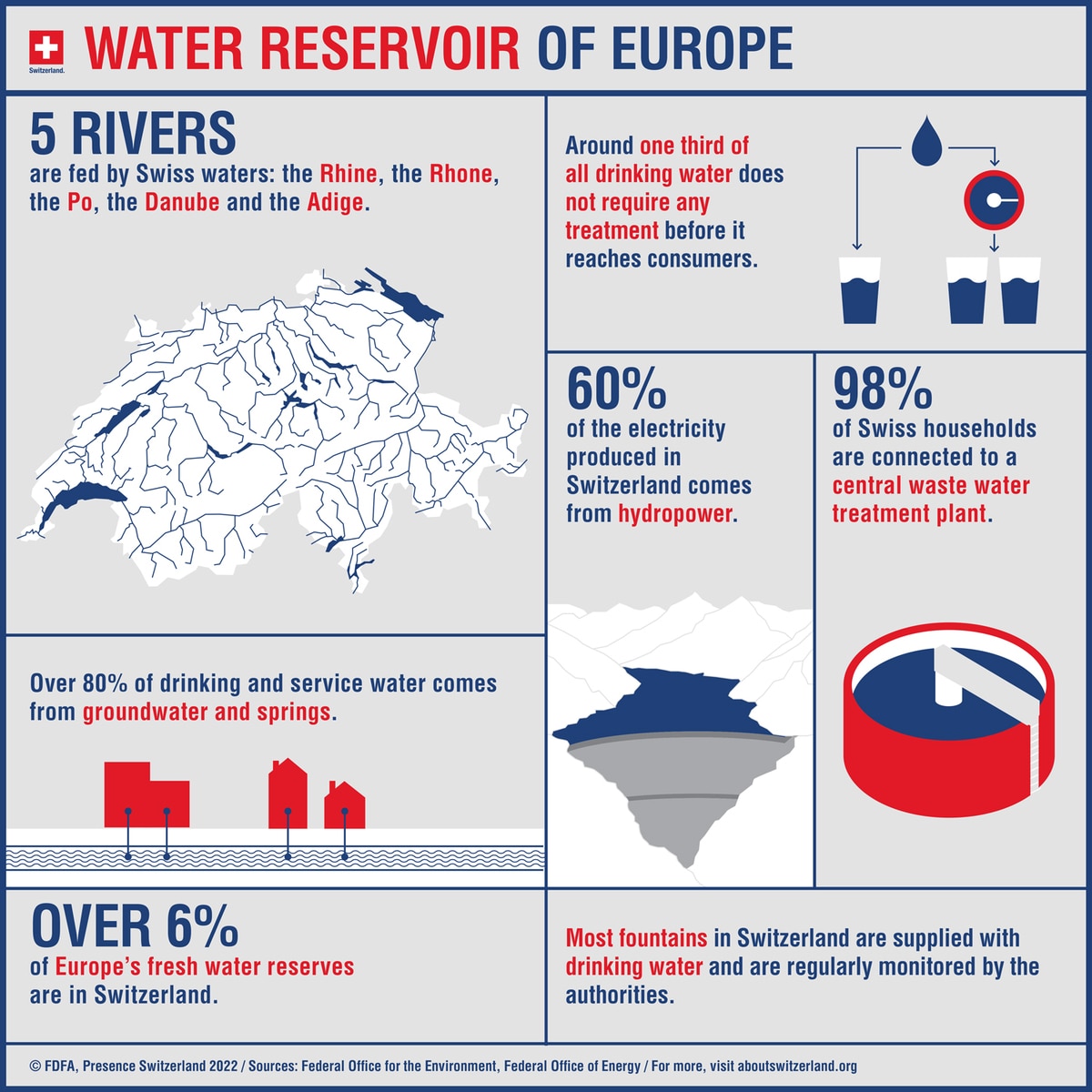Switzerland is a water-rich country. Lakes and rivers cover around 4% of its surface area. It has roughly 61,000km of rivers and streams and around 1,500 lakes. Switzerland also has 6% of Europe's freshwater reserves, and the Rhone, Rhine and Inn all have their headwaters here. In summer, run-off from the Alps flows into the Rhine, Rhone, Po and Danube river plains.
Lakes and Rivers
Switzerland has countless rivers and around 1,500 lakes, the largest of which are Lake Geneva and Lake Constance. The country is a huge reservoir, right in the heart of the continent. This is why it is also known as 'the water tower of Europe'.
These reserves are fed by excess rainwater, spring water and run-off from snow and glacier melt. Lakes and rivers in Switzerland come in many shapes and sizes and their water quality is so good that virtually all are clean enough to swim in.
Swiss lakes
The country's largest lakes – Lake Geneva, Lake Neuchâtel and Lake Bienne – are in the foothills of the Jura. Lake Geneva, which is shared by France and Switzerland, is the largest freshwater lake in central Europe. At 218km2, Lake Neuchâtel is the largest lake wholly on Swiss territory. Lake Constance and Lake Zurich are in the Central Plateau, while Lake Thun, Lake Brienz, Lake Zug and Lake Lucerne are in the Pre-Alps and the northern section of the Alps. Lake Lugano and Lake Maggiore are on the southern side of the Swiss Alps. There are also hundreds of small natural lakes and reservoirs, most of which are in the Alps.
The Gotthard Massif – a European watershed
Switzerland has around 61,000 kilometres of rivers and streams. The largest share is in the canton of Graubünden; the total length of its waterways come to around 11,000km. The headwaters of the Rhone, Rhine, Reuss and Ticino are in the Gotthard massif. The source of the River Inn is in the Graubünden Alps; the River Aare takes it source in the Bernese Alps. The Gotthard Pass forms the watershed between the Mediterranean and the North Sea. The Reuss flows into the Aare, which joins the Rhine at Koblenz in the northwest of Switzerland. The River Ticino flows into the River Po in Italy. Major European rivers also run through Switzerland: the course of the Rhine is 375km long, the Rhone more than 264km and the Inn 90km. The Rhine flows into the North Sea, the Rhone into the Mediterranean, and the Inn into the Black Sea, via the Danube. In the summer months, run-off from the Alps replenishes water levels in the Rhine, Rhone, Po and Danube river plains.
Drinking water
Humans, animals and plants cannot survive without water. Switzerland is renowned for the quality of its groundwater. The quality of drinking water is so good that 38% does not require treatment before it reaches consumers. Swiss households consume an average of 162 litres of water per day, per person. The water in most Swiss public fountains is safe to drink.
Hydropower – a renewable energy source
Roughly 60% of the electricity generated in Switzerland comes from hydropower. Two thirds are produced in the mountain cantons of Uri, Graubünden, Ticino and Valais. Thanks to its topography and high levels of annual rainfall, Switzerland is ideally suited for the production of hydroelectricity. Hydropower remains the country's primary domestic source of renewable energy.

